We are back with an overview of Kate’s tour wardrobe, but first, two updates to Kate’s Calendar.
- Sunday May 15: The Queen, Duke of Edinburgh, and other royals, including William, Kate and Harry, will attend the Royal Windsor Horse Show for a pageant celebrating The Queen’s life at Home Park in Windsor Castle. ITV has more information regarding its live broadcast of Sunday’s pageant here; there is also information on the website for the Queen’s 90th Birthday Celebration.
While we knew HM and Prince Philip were attending, we didn’t know about Kate, William & Harry taking part until seeing verification by Roya Nikkhah of The Sunday Times.
- Monday, May 23: Kate, William & Harry will join HM, Prince Philip and other royals at the Royal Chelsea Flower Show. This is the first time the Duke and Duchess will attend the show in their roles as senior royals. Some may recall the newly created Princess Charlotte chrysanthemum is in competition for Flower of the Year. (More about that here, scroll towards the end of the post.) I expect we will also see the royals spend time at the Field of Poppies exhibit featuring 300,000 individually crocheted poppies.
A quick refresher on the Princess Charlotte Chrysanthemum, taken from sister site What Kate’s Kids Wore: “…the Princess Charlotte flowers will help raise funds for EACH (East Anglia’s Children’s Hospices). Below, the ‘Rossano Charlotte,’ more commonly referred to as the Princess Charlotte chrysanthemum.
The unique flower was created by Deliflor, the largest breeder of chrysanthemums in the world; it is distinguished by those light green tips on the pink flower petals. Deliflor and Beekenkamp Plants, a sister company, are donating 50% of royalties from plant sales to EACH. Kate is patron of EACH, it was one of her first patronages and it remains close to her heart.
The Field of Poppies exhibit is sure to be stunning. Below, an idea of how the exhibit will look as seen in this display at Melbourne’s Federation Square.
More info via Secret London:
The vision behind the exhibit is designer Phillip Johnson, who won Best Show Garden in 2013. He’s using thousands of individually crocheted poppies, which will cover more than 800 square-metres of the grounds of the Royal Hospital Chelsea. The project is being done in partnership with 5000 Poppies,
The story behind 5000 Poppies is extraordinary.
Lynn Berry and Margaret Knight set out to crochet a humble 120 poppies to “plant” at the Shrine of Remembrance in Melbourne Australia for Remembrance Day in 2013 in honour of their fathers Wal Beasley (14/32nd Battalion – Australian Imperial Forces) and Stan Knight (Queen’s Own West Kent Regiment – British Army).
It was this simple tribute of love and honour that sparked a massive community outpouring with an estimated 50,000 plus contributors to the project and hundreds of smaller localised installations throughout Australia, New Zealand and beyond.
You can learn more about 5000 Poppies here, as well as at the Flower Show site here.
++++++++++++++++++++++++++++++++++++++++++++
Now to our primary topic, Kate’s sartorial selections for the recently completed tour of India and Bhutan. It’s something we’ll approach from two perspectives: one viewing tour ensembles strictly via numerics, the other sharing wardrobe critiques and thoughts from two renowned fashion columnists.
We begin with a look at ‘who’ Kate wore in terms of her cadre of ‘go-to’ designers; I counted 8 looks in total. Below you see the first four in this category: the blue Jenny Packham ensemble for the Bollywood fundraiser; two Temperley London styles, the brand’s Delphia separates worn to a birthday party for the Queen and the Desdemona lace dress Kate chose for lunch with the Prime Minister; and the Beulah London gown seen at a Bhutan reception.
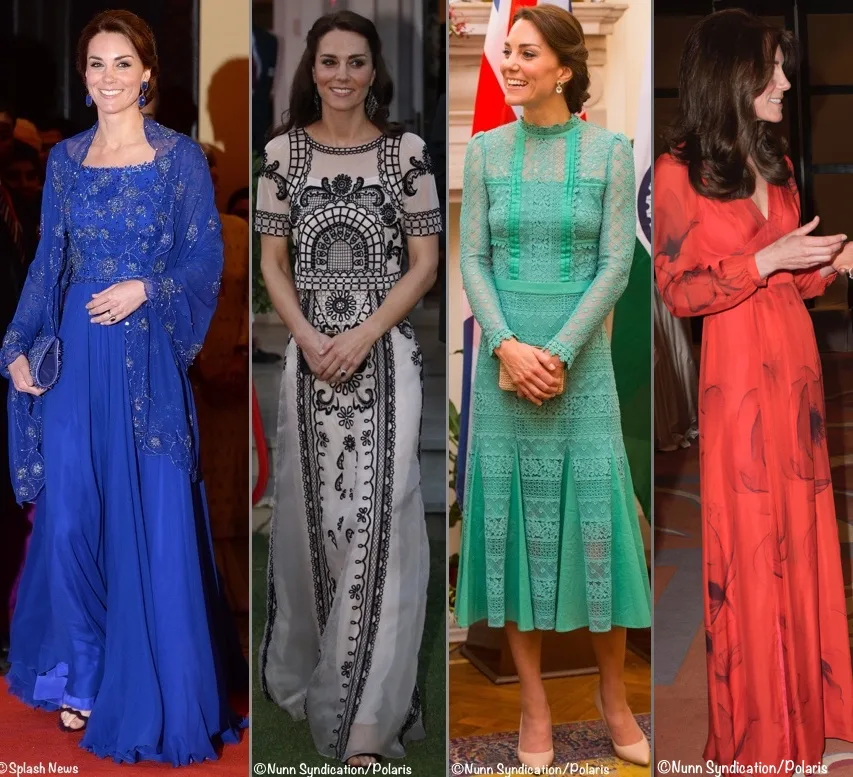
©Splash News/Nunn Syndication, Polaris/Nunn Syndication, Polaris /Nunn Syndication, Polaris
The other four looks from Kate-favored brands: two styles by Emilia Wickstead and two from Alexander McQueen.
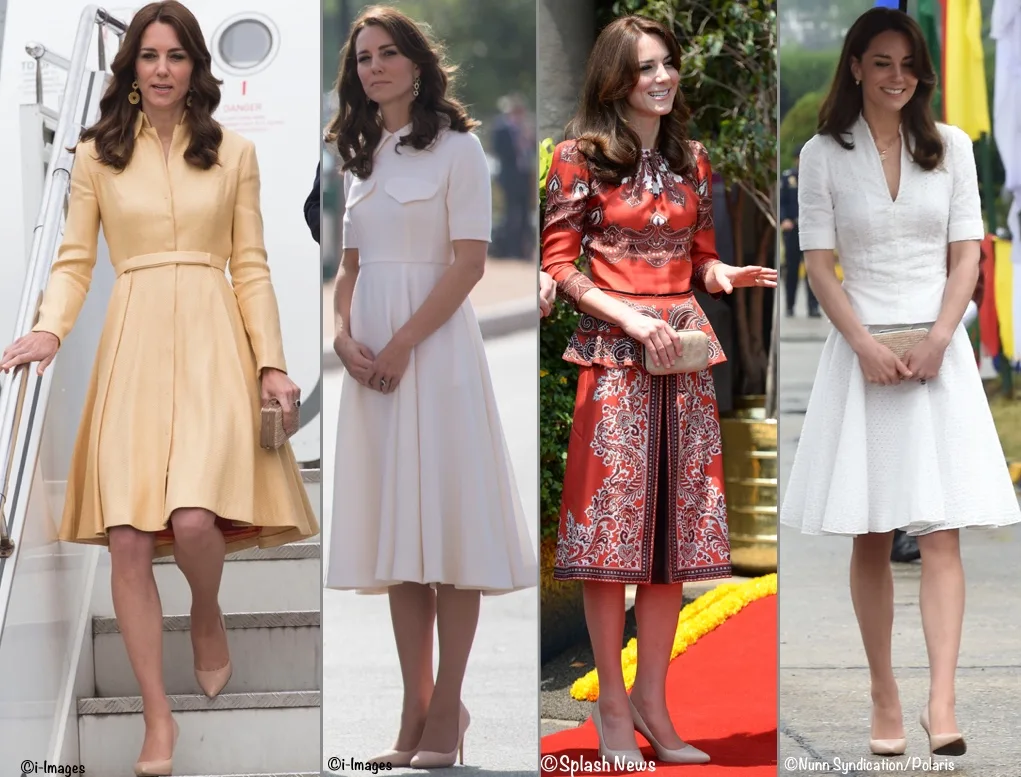
i-Images/i-Images/Splash News/i-Images
I considered adding the two Tory Burch styles to this group, but don’t think we’re at a point where Tory Burch is considered one of Kate’s “go to” luxury labels on the level of Temperley London, Alexander McQueen, Emilia Wickstead, Jenny Packham, and Beulah London.
Following are thoughts on the designers Kate chose from Vanessa Friedman, fashion director & chief fashion critic for The New York Times, in a story titled The Royal (Clothes) Tour of India.
The seven-day British royal tour of India and Bhutan….was an opportunity for many things, including benign national outreach and a show of good will between countries with a complicated history…
But it also raised the bar when it came to the modern art known as diplomatic fashion tradecraft, a.k.a. the use of a ceremonial political event to promote a specific national industry.
Consider the list, in no particular order, of British brands she wore on the tour: Alexander McQueen, Emilia Wickstead, Jenny Packham, Topshop, Paul & Joe, Glamorous.com, L. K. Bennett, Mulberry, Rupert Sanderson, Accessorize/Monsoon, Russell & Bromley, Cassandra Goad, Temperley London, Kiki McDonough, Beulah, Pickett London, Jaeger, Really Wild and Penelope Chilvers.
As the tour just got underway, Lisa Armstrong, the Daily Telegraph’s Fashion Director wrote about Kate’s first three ensembles:
If the Duchess of Cambridge’s wardrobe choices for the first day of her India and Bhutan tour are anything to go by, then royal style enthusiasts are in for a week of her now signature deft balance of diplomacy, ease and classic glamour. Following in the footsteps of the Queen and Princess Diana, the Duchess’s three outfits each showed a respectful consideration for her host country, resulting in some beautifully bold colour choices, but also represented some of the best of British fashion.
Breaking pieces down by a brand’s home country offers the following data. (This is not about country of manufacture, but the country where the brands are located/headquartered.)
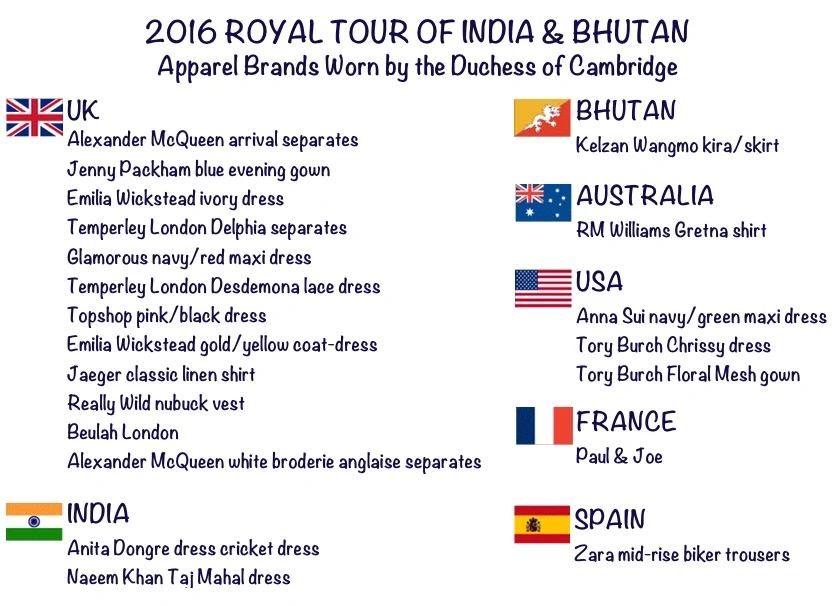
©2016 What Kate Wore
Ms. Armstrong’s column covered the history of the Alexander McQueen pattern worn by the Duchess when arriving in Mumbai.
Its decorative paisley print proved to be a masterful detail, subtly nodding to both Asian and British textile tradition.
The teardrop pattern was originally woven in the Kashmir region in the 11th century, eventually arriving in the United Kingdom via the East India Company in the 1700s. It became known as Paisley after the Scottish town which later began to produce sought-after scarves and fabrics in the swirling prints.
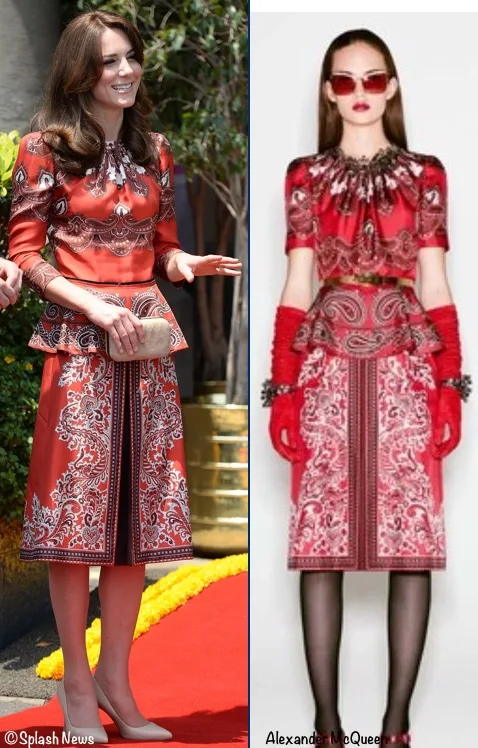
©Splash News/Alexander McQueen
More from Ms. Armstrong’s piece about the first day’s outfits.
Kate enlisted another trusted British designer, Jenny Packham, to create a bespoke cobalt sari-like dress and shawl for the evening gala but care was taken to incorporate Indian elements; the intricate beading on the bodice and shawl was done in India while opulent blue earrings by Jaipur-based jewellers Amrapali finished the ensemble.
Here you have a closer look at the beading and handwork on the dress, shawl and handbag. If I’m not mistaken, many of the flowers are meant to be the lotus, India’s national flower.
Now to another piece in The Telegraph by Ms. Armstrong:
Which brings us to frockery: the art of using frocks to flatter nations.
Frockery requires rigorous research and tact. It must pay subtle yet unmistakable homage of to the traditions and crafts of the host country without laying itself open to accusations of cultural appropriation.
If all that weren’t sufficiently demanding of a frock, it must withstand the withering assault of a thousand mega-powered, fish-eyed, cruelly distorting lenses and the gazes of a gazillion fashion police. It must not turn transparent under flashlight, gust upwards even in a hurricane, crease, sag or droop. Underwear must never show…
Pieces that fit the description of that second paragraph above include the Anita Dongre dress worn in Mumbai and the kira-style skirt seen in Bhutan, crafted of fabric woven by local artisan Kelzang Wangmo.
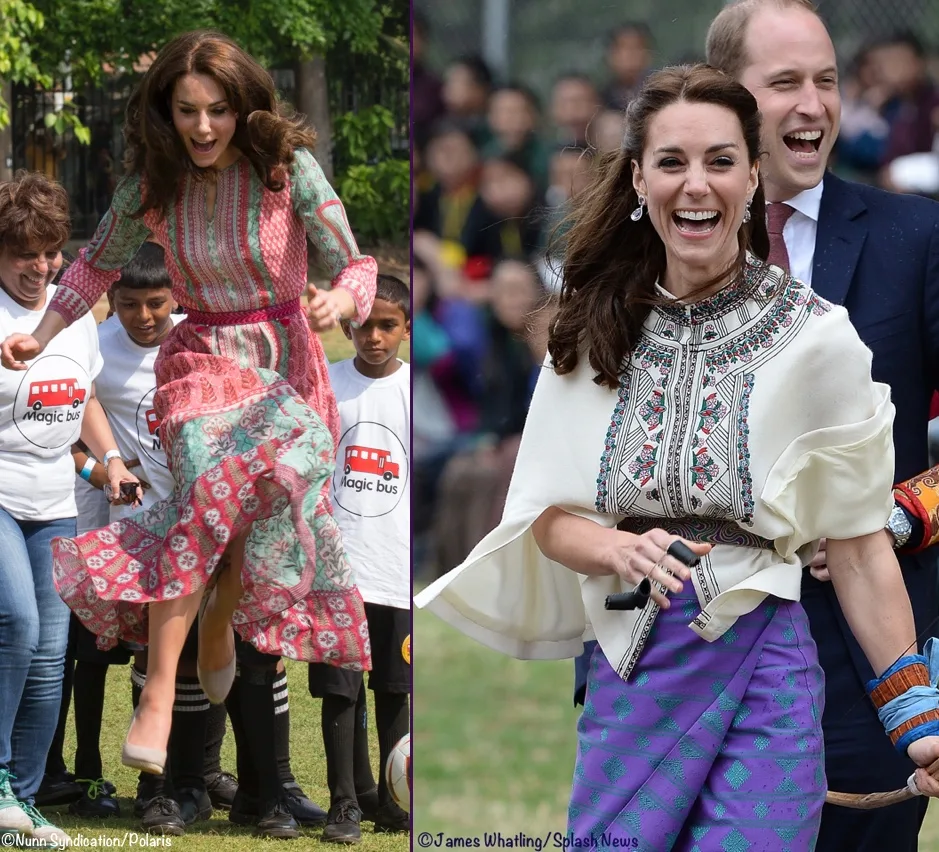
©Nunn Syndication,Polaris/James Whatling, Splash News
The connection to the Duchess’s Taj Mahal dress was obvious; its designer, Naeem Khan, is from India. The red gown by Beulah London made sense for a function in Bhutan, it was covered with poppies, that country’s national flower.
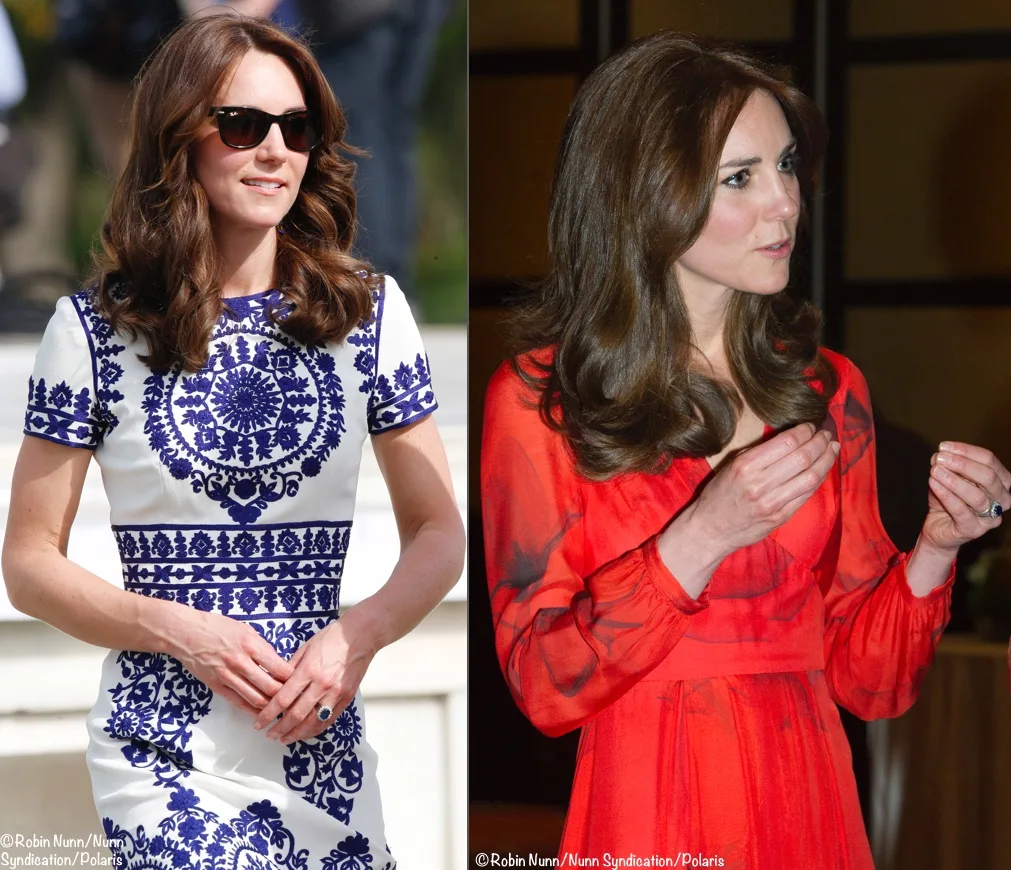
Both Photos ©Robin Nunn/Nunn Syndication/Polaris
At other times the significance was more nuanced, and occasionally overlooked, at least on my part, until pointed out by a source closer to the event. This is from a Times of India story:
Kate looks amazing in the multi-print Tory Burch chrissy dress. The multi-print pattern is a subtle nod to the Indian art.
That wasn’t something I had previously considered. I hope to make time for some more research on how things were received in India and Bhutan.
Back to Ms. Friedman’s column in The Times:
The clothes encompassed the very expensive (McQueen, Packham, Temperley), fast fashion (Topshop, Glamorous) and the already worn (one McQueen outfit), and they included shoes, bags and jewelry — all chronicled obsessively (and daily) in the British and fashion news media.
When it comes to color, here is the breakout: four pieces fell in the reddish/orange-ish category, one was yellow/gold.
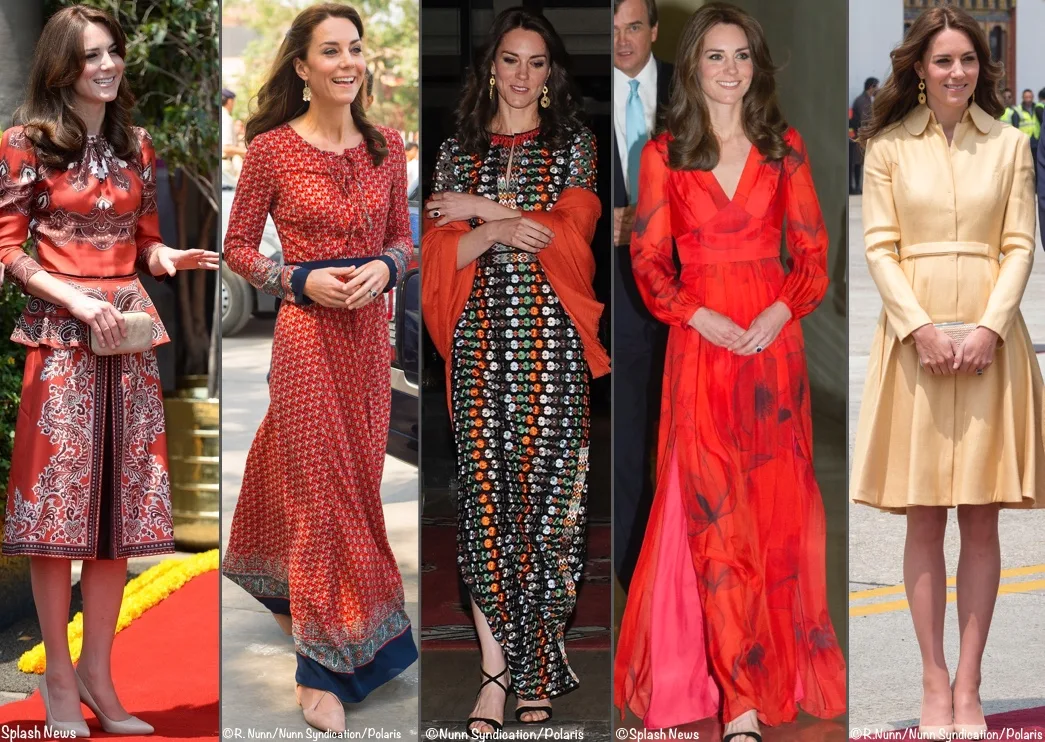
©Splash News/Robin Nunn, Nunn Syndication, Polaris/Nunn Syndication, Polaris/Splash News/Robin Nunn, Nunn Syndication, Polaris
Two were all white (or ivory), 2 more were white with applied motifs, and didn’t readily fit in any color group.
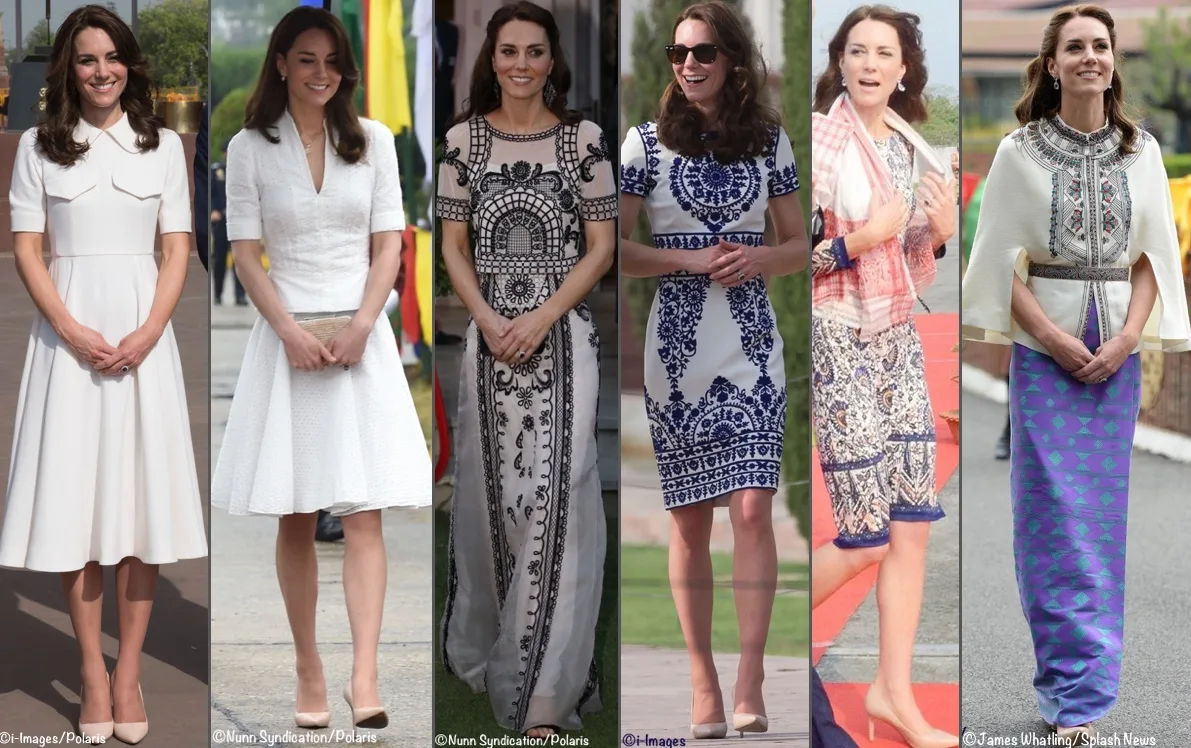
©i-Images, Polaris/Nunn Syndication, Polaris/Nunn Syndication, Polaris/i-Images/James Whatling, Splash News
And we had two that were primarily pink, one in a minty green, one in blue & green, and the royal blue Packham gown.
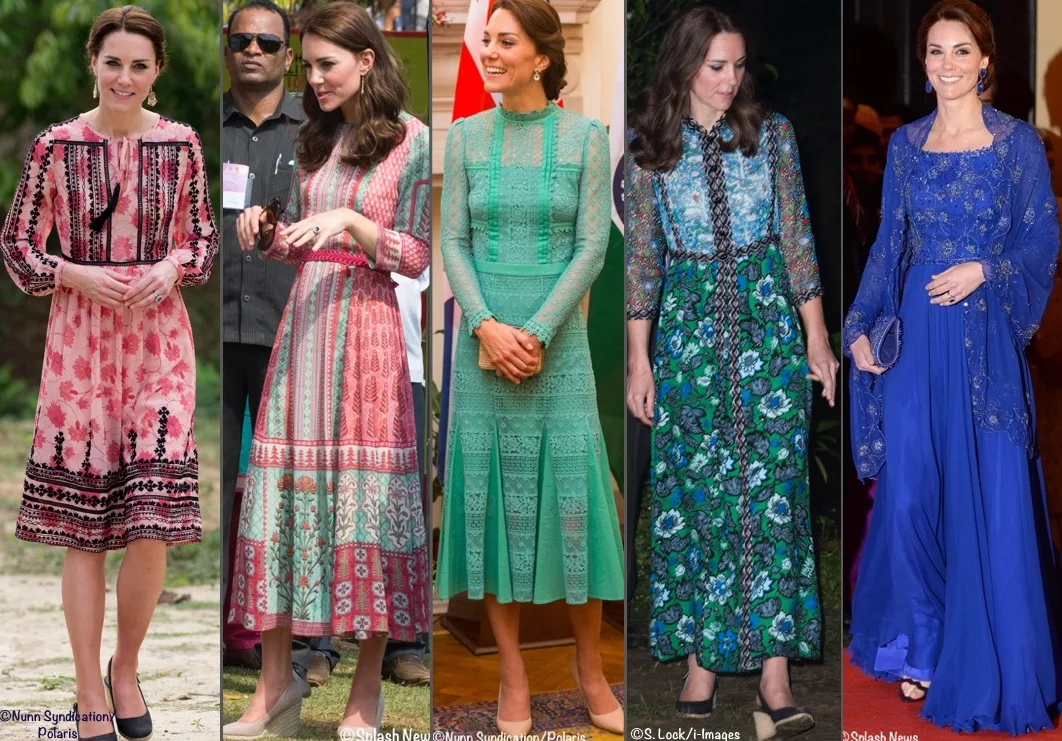
©Nunn Syndication, Polaris /Splash News/Nunn Syndication, Polaris/Stephen Lock, i-Images/Splash News
That does not include the two casual ensembles featuring light tops with darker trousers.
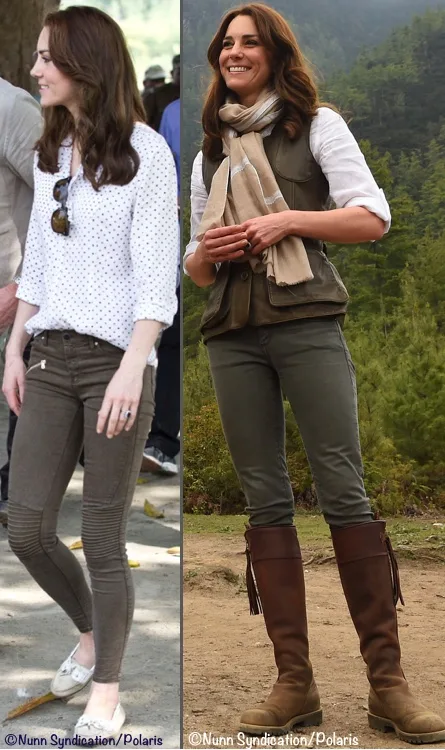
© Robin Nunn, Nunn Syndication, Polaris/Robin Nunn, Nunn Syndication, Polaris
There were three repeated styles seen on this tour:
- the Tory Burch Chrissy dress Kate was in for the departure from India
- the gold Emilia Wickstead coat-dress worn when arriving in Bhutan
- the white McQueen broderie anglaise separates seen when the couple was leaving Bhutan
Lisa Armstrong offered an interesting comment about Kate’s espadrille wedges in The Telegraph:
The ….Monsoon …. wedges are an odd yet endearingly Kate choice, and those £99 wedges have become a trademark, just as Launer bags are The Queen’s, and upturned brims and coats-and-matching-dresses were the Queen Mother’s.
Back to Vanessa Friedman’s Times column:
Compared with William and Catherine’s tour of the East Coast of the United States in 2014 (remember that?), the India trip stands out as a much more powerful piece of sartorial messaging, in part because it so consciously embraced British fashion as broadly as possible, leveraging the duchess’s influence to benefit the elite and the mass ends of the market — big names and those on the rise.
Put another way: She may have gone on a tour of India, but, in doing so, she also took everyone who was watching on a tour of the British clothing industry. That’s quite a trip.
+++++++++++++++++++++++++++++++++++++++++++++++++
Our final tidbit is not directly Kate-related, but something many of us have been following, the 2016 Invictus Games in Florida. This is a brief (1:16) video as the Closing Ceremony draws near.
As we count down to the closing ceremony let’s take a moment to reflect on what these games have all been about…https://t.co/ry4KFVTiAK
— Kensington Palace (@KensingtonRoyal) May 12, 2016
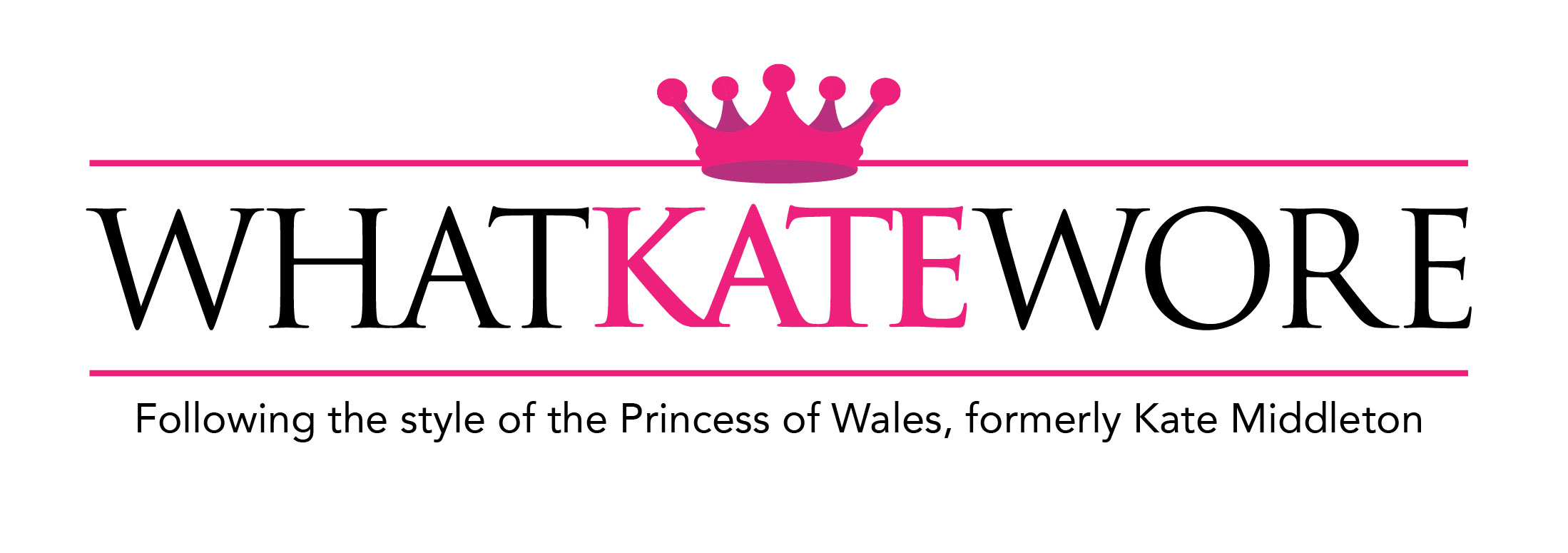

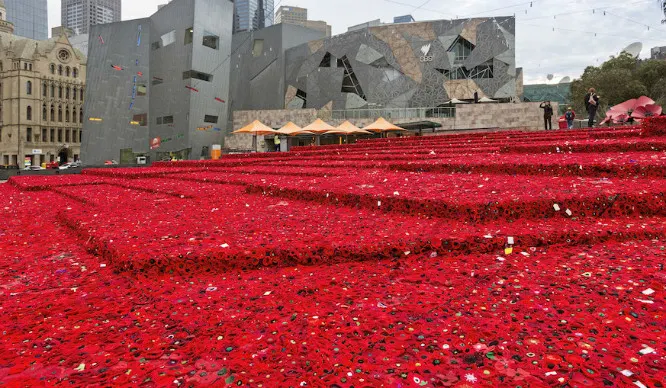
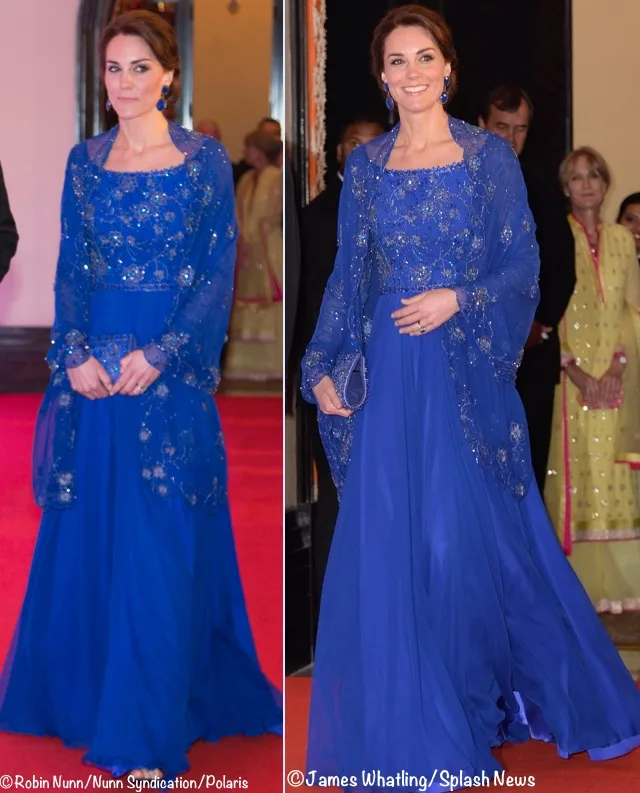
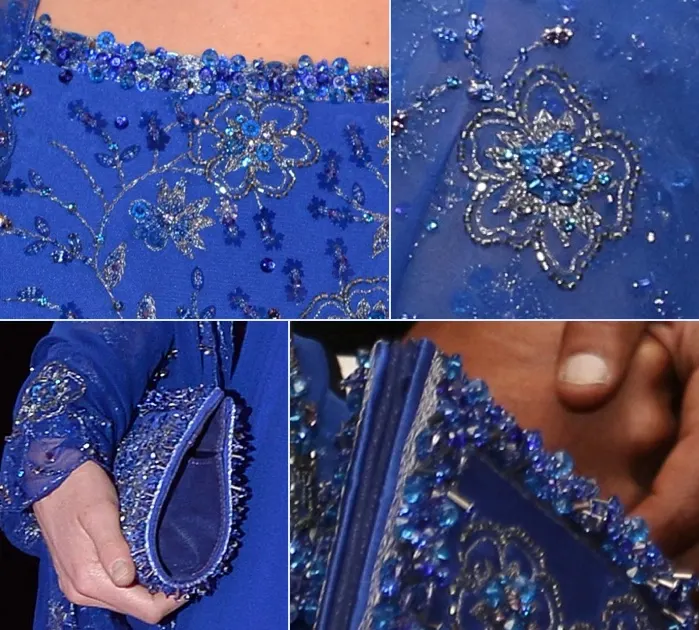
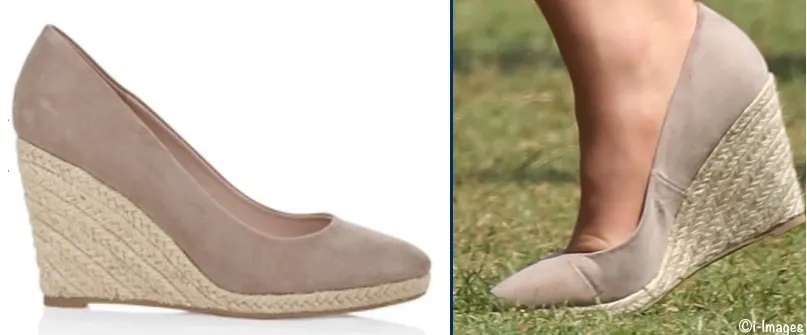

Jessie
Saturday 14th of May 2016
Harry was most impressive at the Invictus Games. He is so good with people and spoke so well to them at the closing ceremonies. He knew numerous stories and names of the athletes and appeared to do it all with out notes. Those games should be his niche cause the rest of his life.
Maryl
Saturday 14th of May 2016
Great post and equally brilliant comments. I learn so much here. I find the discussion on cultural appropriation and cultural diplomacy particularly interesting. I think Kate's fashion choices during the visit are very much in the tradition of the Queen's wardrobes for royal visits. For example, HM wore green almost exclusively during her historic visit to Ireland several years ago (another country with which the UK has a complicated history). She also wore an evening dress embroidered with shamrocks--all very obvious, but I think these 'obvious' signifiers are part of a performative cultural diplomacy in which the royals mostly excel. I'm sure the definition of cultural appropriation is open to debate, but I think generally it suggests exploitation without understanding. That's clearly not the case with royal visits, even if there is the occasional misstep.
Claire
Saturday 14th of May 2016
Really interesting post, thank you!
A question: in the collage starting with the two all-White outfits, where's the photo second-from-the-right taken at? I don't remember this dress at all...
Imke
Saturday 14th of May 2016
She wore it leaving India for Bhutan. There were only two or three pics available. No wonder, only few saw them
ali
Saturday 14th of May 2016
Her clothes this tour were hit and miss for me. I do think her stylist got a bit carried away at times with themes and motifs. She had some lovely items but many a piece that did look like a group of advisors choice. I really do think that Catherine needs a really really good stylist, and only one. I do not think Catherine herself is all that great at picking out clothes, I am not either, and happy to turn it over to others, I just think she has turned it over to not the best stylists. She is so hit and miss.
TravelingBlush
Friday 13th of May 2016
This must be one of your most thoughtful post, bravo. And thanks for referring to other commentators in the media.
One thing that I enjoy reading on this blog is the comments section. I do sometimes wonder though, whether I don't understand the emaning of some terms like 'frumpy', 'matronly', etc which had been used to describe Kate in some of the clothes in this tour. My initial reaction is to scoff and say, "well maybe in a Kim Kardashian era these would be matronly". But coming from someone Asian, living in Asia, none of these choices would be termed thusly. These are not 'modest' looks either, given the styling, makeup and accessories. These would be what an Asian modern, upper class young woman would wear to public events.
In terms of styling, perhaps it would be interesting to compare the dresses here with the past Asia tour of Malaysia and Singapore. The main difference would be the color - she wore a lot of pastels and white. Second would be that she did not wear a lot of prints/motifs. Most of the clothes from the India-Bhutan tour would look out of place in Malaysia in terms of color, styling,and just general landscape of the place and people (even though there are many people of South Asian descent in Malaysia).
So I think, a lot of thought had gone into the clothes and overall styling. I would not put too much factor in the designers, though. She was looking for a certain look, and somebody had something fitting. Most are western designers, since that would be most accessible, but the low-budget choices here again underlines the priority of fitting the moment.
I would be interested to read what you could find one the reviews by local media.